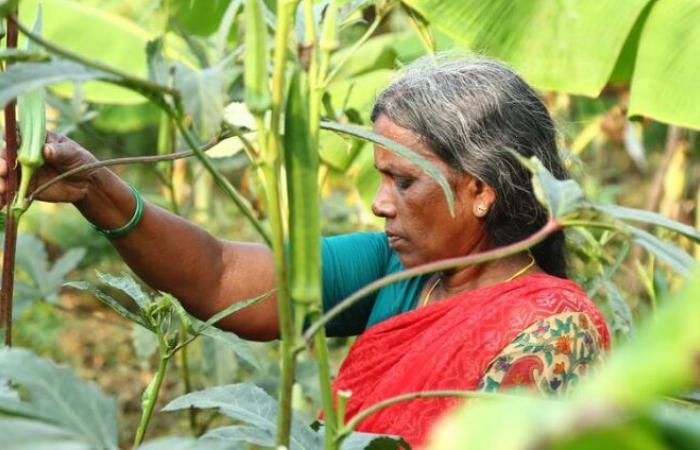Since 2016, the largest agroecological transition in the world has been taking place in Andhra Pradesh. Encouraged by their government, nearly a million micro-farmers – primarily women – have adopted an advanced form of agroecology called “natural agriculture managed by communities” (Dorin 2022, Dorin et al. 2024).
The co-authors of the AgroEco2050 collective foresight, including Bruno Dorin, economist at CIRAD, debated, quantified and compared the macroeconomic impact that a scenario of full adoption of this natural agriculture (100% agroecological sociotechnical regime) could have with a very contrasted, that of an “Industrial intensification of food and agriculture” following the currently dominant model of the Green Revolution (100% socio-technical regime industrial).
The performance of the two models is evaluated by 2050 in various areas such as land use, food production, employment, economic growth and even income inequalities between farmers and other workers.
The exercise was based on a new version of the Agribiom retro-prospective model (Dorin and Joly 2020) as well as on a series of workshops which, from 2020 to 2022 in India, made it possible to bring together and create dialogue between multiple visions and expertise: scientists from various disciplines, decision-makers or administrators, representatives of farmers or NGOs, etc. With an ultimate objective: to help societies and their governments to better understand, choose and collectively configure the future world where they would like to live and work.
“Subject to adequate public policies, the natural agriculture scenario reveals various advantages that the academic literature on agroecology had not previously highlighted”reveals Bruno Dorin. It would indeed allow, compared to the industrial intensification scenario for 2050:
- To increase food production per capita, in quantity (+ 1000 kcal/day) as well as in nutritional and health quality;
- To regenerate vast areas of land left fallow by industrial agriculture (+2.8 million hectares) and to produce there all year round almost without irrigation thanks to the strong diversification of production, soil life and the microclimates thus created or recreated;
- To significantly reduce the general unemployment rate (from 30% to 7%) through employment in agroecology (+5 million workers);
- To increase income per agricultural worker primarily by saving industrial inputs (laboratory seeds, irrigation, fertilizers, pesticides, fuel, machinery and robotics, credit, insurance, etc.);
- To stem agrarian crises through a significant reduction in the average income differential between non-agricultural workers and agricultural workers (from 47% to 22%);
- To ultimately increase the general rate of growth of the economy and income (from + 6% to + 6.5% per year between 2020 and 2050).
“This agroecological scenario would be even more advantageous if the current billions of euros in subsidies to industrial agriculture and food were replaced by some kind of payments for environmental services (PES)”explains Bruno Dorin. These would be paid per person (and not per hectare) and according to the intensity of adoption of agronomic practices that are known to be jointly beneficial on various environmental levels (soil, water, climate, biodiversity). These PES would pay for local and global services which humanity greatly needs today, and which could very effectively be provided via agroecology to hundreds of millions of agricultural micro-producers in the South who will not be able, as in the North, to increase their income by expansion and robotization of their agricultural area (Dorin et al. 2013, Dorin 2017): mitigation of climate change (thanks to carbon storage in the soil), saving and filtering of water, resilience to shocks climatic and economic (thanks to agro-biodiversity), reduction of environmental but also human health costs (undernutrition, overweight, diabetes, cancers, etc.).
In order to stimulate such reflections and debates elsewhere in India but also around the world, the book also includes a unique collection of statistical estimates over more than half a century (from the 1960s to 2020) at three geographical scales (World, India and Andhra Pradesh) to illustrate the multiple and interconnected dimensions of agri-food systems and their structural transformations.
The method and results of this AgroEco2050 retrospective in India were presented and debated in October 2023 with the authorities of Andhra Pradesh (State Government Secretariat) then in New Delhi (Federal Ministry of Agriculture and NITI Aayog for the Prime Minister). They also led to the implementation in 2022-23 of a similar retro-prospective in Senegal (AgroEco2050-Senegal) whose results will be co-published at the end of 2024 by CIRAD, FAO and ISRA-BAME. These exercises also led to the launch of India-Africa cooperation on agroecology, with a first field visit to Andhra Pradesh (October 2023) by a delegation from 7 African countries (Benin, Madagascar, Malawi, Rwanda, Senegal, Tunisia, Zambia).
For Bruno Dorin: “These AgroEco2050 prospects could also encourage international organizations (IPCC, IPBES, World Bank, etc.) to integrate such large-scale micro-agroecology visions and practices into global models and scenarios, in order to make this visible and more likely. socio-technical regime option which seems more beneficial than industrial in many respects ».
References
Dorin B., Poisot A-S., Vijay Kumar T. 2024. Agro-industry versus agroecology? Two macroeconomic scenarios for 2050 in Andhra Pradesh, India. International Cooperation Centre of Agricultural Research for Development (CIRAD, France), Food and Agriculture Organization of the United Nations (FAO, Italy), Rythu Sadhikara Samstha (RySS, India), 140 p. https://openknowledge.fao.org/items/153b23b6-a62d-450c-9a0c-6dccc0659a43
FAO, Cirad, RySS, 2024. Re-thinking food systems in Andhra Pradesh, India. How Natural Farming could feed the future (AgroEco2050 Brief), FAO, Rome, 12 p.
Other useful references
Dorin B., Degron R., Landy F., 2024. Industrial agriculture, organic agriculture and agroecology: cross-references between Europe and India, Cahiers Agricultures, 33:31, pp. 1-10. https://doi.org/10.1051/cagri/2024026
Dorin B., 2022. Theory, Practice and Challenges of Agroecology in India, International Journal of Agricultural Sustainability, 20:2, pp. 153-67. https://doi.org/10.1080/14735903.2021.1920760
Dorin B., Joly P.B., 2020. Modelling world agriculture as a learning machine? From mainstream models to Agribiom 1.0, Land Use Policy, 96:July, pp. 103624. https://doi.org/10.1016/j.landusepol.2018.09.028
Dorin B., 2017. India and Africa in the Global Agricultural System (1960-2050), Economic & Political Weekly, LII:25-26, pp. 5-13.
Dorin B., Hourcade J.C., Benoit-Cattin M., 2013. A World without Farmers? The Lewis Path Revisited, CIRED Working Paper, 47, April, pp. 1-26.






